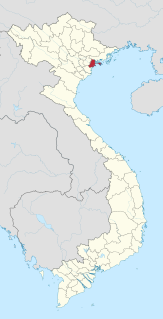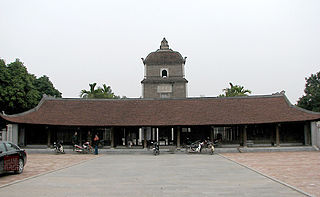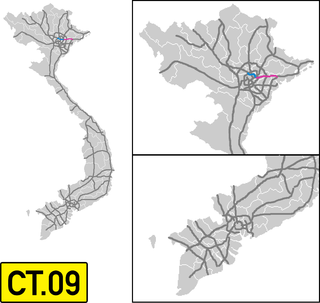Related Research Articles

Transportation in Vietnam is improving rapidly in terms of both quantity and quality. Especially road traffic is growing rapidly but the major roads are dangerous and slow to travel on due to outdated design and an inappropriate traffic mix. In recent years, the construction of expressways has accelerated. Air travel is also important for long distance travel. Metro systems are under construction in the two metropolises of Vietnam, Hanoi and Ho Chi Minh City.
Articles related to Vietnam and Vietnamese culture include:

Haiphong, or Hai Phong, is a major industrial city and the third-largest in Vietnam. Hai Phong is also the center of technology, economy, culture, medicine, education, science and trade in the Red River delta.

Bắc Ninh is a province of Vietnam, located in the Red River Delta of the northern part of the country. It is the smallest province of Vietnam and is situated to the east of the nation's capital, Hanoi, and borders Bắc Giang Province, Hưng Yên Province, Hải Dương Province and Hanoi. The province covers an area of 822.71 square kilometres and as of 2019 it had a population of 1,368,840. The province's name literally means "northern serenity".

Quảng Ninh is a province along the northeastern coast of Vietnam. It is about 153 km (95 mi) east of Hanoi, comprising four cities, two district-level towns and seven rural districts. The province is home to Hạ Long Bay, a World Heritage Site. The provincial capital is Hạ Long. The province covers an area of 6178.21 square kilometres and as of 2019 it had a population of 1,320,324. Nearly 80% of the province is mountainous with abundant land, forest water and mineral resources. Nearly 90% of coal output in the country is extracted in this province. Hạ Long Bay has 1,969 islands, out of which 989 have been given names.

South Central Coast or Nam Trung Bộ is one of the regions of Vietnam. It consists of the independent municipality of Đà Nẵng and seven other provinces. The two southern provinces Ninh Thuận and Bình Thuận are sometimes seen as part of the Southeast region. The Paracel Islands, and Spratly Islands, are also part of this region.

Hạ Long is the capital city and 1st-class provincial city of Quảng Ninh Province, Vietnam. The name Hạ Long means "descending dragon". The city was created in 1993, when the old capital, Hòn Gai, was merged with Bãi Cháy – the main tourist area. The city mainly lies on Hạ Long Bay. It is located at about 178 km (111 mi) east of Hanoi. The population in 2013 was 227,000.

Vietnam Coast Guard is the coast guard of Vietnam. Until 2013, it was a branch of Vietnam's military, the Vietnam People's Army, and falls under the management of the Vietnamese Ministry of Defence. Since August 27, 2013, it has been transferred under the direct management of the Government of Vietnam. Since its creation in the late 1990s, the Vietnam Coast Guard plays an important role in maintaining sea security and protection of the exclusive economic zone (EEZ) and continental shelf boundary. It has dispatched forces in waters in overlapping areas between Vietnam and foreign countries, providing protection and assistance to local fishermen when necessary. In addition, the Vietnam Coast Guard perform search and rescue duties, along with their duties of combating and preventing smuggling, piracy, and trade fraud in Vietnamese waters.

Van Don International Airport or Ha Long Airport, is an airport in Vân Đồn District, Quảng Ninh Province, Vietnam, home to World Heritage Ha Long Bay. It is located about 50 km (31 mi) away from Hạ Long and 20 km (12 mi) from Cẩm Phả. It is the first private airport in Vietnam, built and operated by Sun Group.

Tourism in Vietnam is a component of the modern Vietnamese economy. In 2019, Vietnam received 18 million international arrivals, up from 2.1 million in the year 2000. The Vietnam National Administration of Tourism is following a long-term plan to diversify the tourism industry, which brings foreign exchange into the country.
The Ministry of Industry and Trade is the government ministry in Vietnam responsible for the advancement, promotion, governance, regulation, management and growth of industry and trade. The former Ministry of Trade has its origins in 1945 with the formation of the modern National Unification Cabinet, and became a ministry in its own right in 1955. The Ministry of Trade merged with the Ministry of Industry in 2007 to form the Ministry of Industry and trade. The current Minister of Industry and Trade is Nguyễn Hồng Diên. Ministry main offices are located in Hanoi.
The North–South express railway is a proposed high speed railway in Vietnam. The line would begin in Hanoi, crossing provinces and municipalities of Hanoi, Hà Tây, Hà Nam, Ninh Bình, Thanh Hóa, Nghệ An, Hà Tĩnh, Quảng Bình, Quảng Trị, Thừa Thiên-Huế, Đà Nẵng, Quảng Nam, Quảng Ngãi, Bình Định, Phú Yên, Khánh Hòa, Ninh Thuận, Bình Thuận, Đồng Nai, Bình Dương, and coming to an end in Ho Chi Minh City. The rail line would connect the two most developed areas in Vietnam which are Hanoi in the North's Red River Delta in the north and Ho Chi Minh City in the South's Mekong River Delta. The total proposed length would be 1,570 kilometres (980 mi), compared with the 1,729-kilometre (1,074 mi) of the old railway line. The cost of the line is estimated at US$55.85 billion, to be funded by official development assistance from Japan and by the Vietnamese government itself. The project is planned to be implemented in three phases: Hanoi to Vinh city (285 km); Vinh City to Nha Trang (896 km); and Nha Trang to Ho Chi Minh City (364 km). Construction activities on the first phase are expected to commence in 2020, and the whole project is scheduled for completion in 2050. This project is part of the country's railway transport development strategy by 2020 with a vision to 2050. The project is also part of the Trans-Asian railway network.

Bắc Giang is a province of Vietnam, located in the Northeast region of the country, and situated 50 kilometres (31 mi) to the east of Hanoi. The province covers 3895.59 square kilometres, and, as of 2019, its population was 1,803,950 people.

Bính Bridge is a cable-stayed bridge across the Cấm River connecting the Hai Phong city with Thủy Nguyên District and out to Quảng Ninh.

The Bangladesh, China, India and Myanmar Economic Corridor (BCIM) is a proposed corridor connecting India and China through Myanmar and Bangladesh as a corridor.

The 2014 Vietnamese Cup is the 22nd edition of the Vietnamese Cup. It began on 8 March 2014 and finished on 17 August 2014.

Singapore–Vietnam relations refer to the bilateral relations between the Republic of Singapore and the Socialist Republic of Vietnam. Singapore and Vietnam started the trade relations in the 19th century. Since the anti-communist policy of Singapore, Singapore supported South Vietnam before the unification of Vietnam. Singapore also started formal diplomatic relations with North Vietnam on August 1, 1973. After the unification of Vietnam, Singapore started to improve its relations with the Socialist Republic of Vietnam. The relations was worsened during the Cambodian–Vietnamese War, but it has now revived after the People's Army of Vietnam withdrawal from Cambodia.
The Belt and Road Forum for International Cooperation is an international political and economical forum.

Ninh Binh–Hai PhongºQuang Ninh Expressway is a partially completed expressway in Vietnam, running for xx km connecting Ninh Binh to Quang Ninh. The route connects the northern coastal provinces of Vietnam with the North-South expressway.
References
- ↑ "China and Vietnam Issues a Joint Communiqué". Ministry of Foreign Affairs of the People's Republic of China.
- ↑ "Joint Communique of the Leaders' Roundtable of the 2nd Belt and Road Forum for International Cooperation". Ministry of Foreign Affairs of the People's Republic of China.
- 1 2 Le, Hong Hiep (April 12, 2018). "Potholes lie ahead for China's Belt and Road Initiative in Vietnam". VnExpress International.
- ↑ "As trade-war-weary China sends money, old foe Vietnam is unsure whether to cheer or fear". Los Angeles Times. January 3, 2019.
- ↑ "HN urban railway told to start operation in 2018". Viet Nam News. March 28, 2017.
- ↑ "List of Deliverables of the Second Belt and Road Forum for International Cooperation". Second Belt and Road Forum for International Cooperation.
